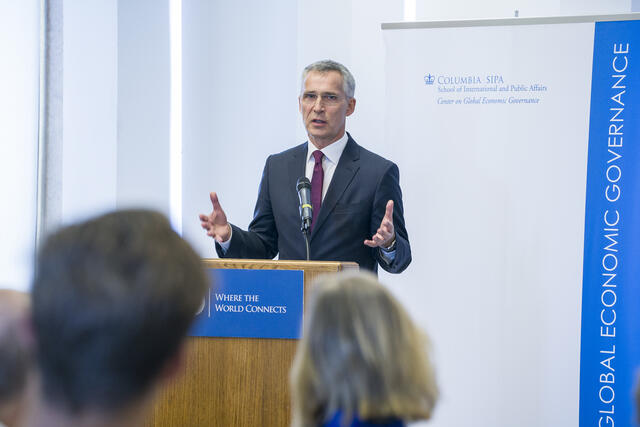
NATO’s Place in the Future

Visiting New York City on a balmy fall day, NATO Secretary General Jens Stoltenberg alluded to the twisted steel beam from the World Trade Center that rests near the entrance of NATO’s Brussels headquarters.
The historic events of September 11, 2001, prompted NATO to invoke Article 5—which states “an attack against one Ally is considered as an attack against all Allies”—for the first time in the alliance’s 70-year history.
“The way our nations worked together after 9/11 shows the strength of the transatlantic bond, our forces standing together,” Stoltenberg said in his remarks on “NATO: Maintaining Security in a Changing World.” The September 26 event—the annual Ambassador Donald and Vera Blinken Lecture on Global Governance — was sponsored by SIPA’s Center on Global Economic Governance in partnership with Columbia University’s World Leaders Forum.
In a world that appears on the brink of another conflict, Stoltenberg examined the pressures NATO faces from the shifting of the global balance of power and new technology of warfare challenging the western world. These threats necessitate the NATO alliance to be ever-ready and agile across Europe.
As NATO defends its democratic values, the spread of autocratic regimes, nationalist leaders, and disinformation campaigns from both state and non-state actors erode that very tradition.
“In many countries, people are denied the right to elect their own leaders, imprisoned for voicing their political views, and closely monitored by the governments,” Stoltenberg said. “Yet, from Moscow to Hong Kong, we can always see how people are willing to stand up and fight for freedom, whatever [the] odds.”
NATO’s creation at the end of World War II saw the United States in an unparalleled advantage and Europe on the brink of collapse. With the Marshall Plan providing the necessary economic infusion to Europe, and NATO offering military protection, the West oversaw unprecedented economic growth that accounted for 75 percent of the world’s GDP. But that economic dominance, Stoltenberg said, has shifted.
“Today, the countries of the NATO alliance account for roughly half of global GDP,” he said. “Over the next decade, China is forecast to overtake the United States as the largest economy in the world. And military spending by China has almost doubled over the last ten years, giving it the second-largest defense budget in the world after the United States.”
Stoltenberg described the strategic technological goals of a rising China.
“President Xi has announced plans for China to become the world's leading power in artificial intelligence by the end of 2030 and is investing billions of dollars to make it happen,” he said. “Our future security depends on our ability to understand, adopt, and implement emerging disruptive technologies.”
Technological advances in cyberspace—highlighted by both recent suspected Chinese attacks on the multinational European defense company Airbus and the use of drones as weapons-delivery platforms in the oil fields of Saudi Arabia—present a challenge for NATO. Large, multifaceted military alliances are hampered by complicated procurement processes and integration efforts.
“Our future security depends on our ability to understand, adopt, and implement emerging disruptive technologies,” Stoltenberg said.
The dangers of cyberspace conflict, he added, could often lead to conventional responses,
“We have decided that a cyberattack can trigger Article 5, meaning that we regard cyberattacks potentially as damaging and as dangerous as conventional attacks or any other attack, not necessarily in cyber,” Stoltenberg said. “It's up to us to decide how we respond. So, of course, we can respond to a cyberattack in cyber, but we can also respond to a cyberattack in all other domains.”
Noting that “Russia is not the partner we once hoped it to be,” Stoltenberg assessed NATO’s options in countering that nation’s deployment of nuclear-capable missiles throughout Europe.
“We are working on air and missile defense, because these are cruise missiles and the Russian missiles are cruise missiles and of course our air and missile defense can also be part of the answer,” he said. “We are looking into the readiness of our forces, better intelligence, early warning...with the battlegroups in the eastern part of the Alliance, we have tripled the size of the NATO Response Force.”
As NATO wrestles with a spoiling Russia, rising China, and an uncertain technological frontier, the West is poised to either face these challenges together or retreat from its alliance-based system of security.
— Daniel E. White MPA ’20